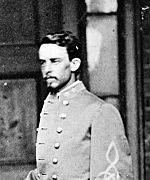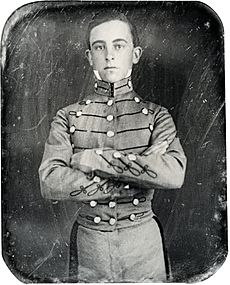Walter H. Taylor facts for kids
Quick facts for kids
Walter Herron Taylor
|
|
|---|---|

Lt. Col. Walter H. Taylor, Lee's aide-de-camp
|
|
| Member of the Virginia Senate from the Norfolk Virginia district |
|
| In office 1869–1873 |
|
| Personal details | |
| Born | June 13, 1838 Norfolk, Virginia |
| Died | March 1, 1916 (aged 77) Norfolk, Virginia |
| Resting place | Elmwood Cemetery, Norfolk, Virginia |
| Alma mater | Virginia Military Institute |
| Military service | |
| Allegiance | |
| Branch/service | |
| Years of service | 1861–1865 |
| Rank | |
| Commands | Assistant Adjutant General, Army of Northern Virginia |
| Battles/wars | American Civil War |
Walter Herron Taylor (born June 13, 1838 – died March 1, 1916) was an important American figure from Norfolk, Virginia. He worked as a banker, lawyer, soldier, politician, and railroad executive. During the American Civil War, he fought for the Confederate States Army. He became a key helper, or aide, to General Robert E. Lee and reached the rank of Colonel. After the war, Taylor served as a senator in the Virginia General Assembly. He also worked as a lawyer for major railroad companies like the Norfolk and Western Railway and the Virginian Railway.
Contents
Walter Taylor's Early Life
Walter Taylor was born in Norfolk, Virginia, on June 13, 1838. He was one of ten children. His father, Walter H. Taylor Sr., passed away when Walter was young. His mother, Cornelia Wickham Cowdery, then became the head of their large family.
Walter came from a well-known family in Virginia. Some of his ancestors were early leaders in the area. He went to local private schools, including Norfolk Academy. Later, he studied at the Virginia Military Institute (VMI) in Lexington, Virginia. He graduated from VMI in 1857. After college, he started his career as a railroad clerk and then became a banker in Norfolk.
Walter Taylor in the Civil War
In 1859, after an event called John Brown's raid on Harpers Ferry, Walter Taylor joined a local military group. When Virginia decided to leave the United States in April 1861, Taylor joined the Confederate States Army. His older brother, Richard, also joined and became a Major.
Walter Taylor was soon assigned to work for General Robert E. Lee. He became Lee's main aide-de-camp, which means he was a very important assistant. General Lee had a small team, so Taylor had many big jobs. He wrote messages and orders for Lee. He also scouted areas himself and often delivered messages directly to army commanders. For example, he carried a famous order from Lee during the Battle of Gettysburg.
Taylor also managed who could see General Lee. When General Lee took command of the Army of Northern Virginia in June 1862, Taylor became the assistant adjutant general for that army. This was a very important role. He was promoted to lieutenant colonel in December 1863.
Lieutenant Colonel Taylor was with General Lee when the war ended at Appomattox Court House. After the war, people often called him "Colonel" as a sign of respect.
Walter Taylor's Family Life
Walter Taylor was engaged to Elizabeth Selden "Bettie" Saunders. During the war, Miss Saunders lived in Richmond, Virginia. She worked for the Confederate Mint and the Medical Department.
Near the end of the war, as the city of Petersburg was about to fall, General Lee gave Taylor special permission. He allowed Taylor to go to Richmond to marry Miss Saunders. A messenger told Bettie, and she quickly made plans with Reverend Dr. Charles Minnigerode.
In the early morning of April 3, 1865, just before Confederate soldiers left Richmond and the city caught fire, Taylor and Miss Saunders were married. One week after the war ended, Taylor returned to Richmond with General Lee. He then picked up his new wife and drove her back to Norfolk.
Walter and Bettie had several children. They had two daughters and three sons who grew up: Bland Selden, Cornelia Wickham, Walter Herron Jr., John Saunders, and Robert Edward Lee Taylor.
Walter Taylor's Post-War Career
After the war, Taylor went back to his banking job in Norfolk. He also worked as a lawyer, especially for railroad companies that were rebuilding. He quickly received a pardon from the government.
He was elected to local offices and then to the Virginia General Assembly as a senator. He served from 1869 to 1873. He strongly disagreed with the Readjuster Party, a political group at the time.
In 1870, General Lee visited Norfolk for the last time. Colonel Taylor met him and guided him through the crowds. Lee passed away less than five months later. Also in 1870, Taylor joined the VMI Board of Visitors, serving until 1873. He returned to the VMI board from 1914 until his death.
In 1877, Taylor became the president of the Marine Bank, a position he held for 39 years. He also served on the board of directors for the Norfolk and Western Railway. Later, Taylor helped develop the Ocean View area in Norfolk County. This area became a popular resort and a streetcar suburb of Norfolk. A steam locomotive used there was even named the "Walter H. Taylor."
In 1907, Taylor was a lawyer for the new Virginian Railway. He met the railway's founder, millionaire Henry Huttleston Rogers, and the famous writer Mark Twain. They were in Norfolk for the opening of the Jamestown Exposition. Twain and Taylor even rode together in an early automobile, which Twain called an "infernal machine."
Defending General Lee's Legacy
After the war, Walter Taylor spent a lot of time defending General Lee's reputation. He also helped clear up arguments about the Army of Northern Virginia. Taylor worked with the Southern Historical Society. He was also a member of several groups for Confederate veterans.
Many former generals from both sides of the war asked Taylor for information to settle their arguments about wartime events. Because so many people asked him, Taylor decided to write a book to set the record straight. He was the first Confederate to get permission from the U.S. government to look at national archives about the Union army.
In 1877, he published Four Years with General Lee. This book shared many stories about General Lee. It contained a lot of facts from the national archives. It was not very popular at first. Later, Taylor wrote another book, Robert E. Lee, His Campaign in Virginia, 1861–1865 (1906). This book was written more like a story and quickly became a best seller.
Death and Legacy
Walter H. Taylor passed away from cancer on March 1, 1916. He is buried in Elmwood Cemetery in Norfolk. The Walter H. Taylor Elementary School in Norfolk is named in his honor.
Works by Taylor
- Taylor, Walter H., Belmont, John S., Tower, R. Lockwood, Lee's Adjutant: The Wartime Letters of Colonel Walter Herron Taylor, 1862–1865, University of South Carolina Press, 1995, ISBN: 1-57003-021-9.




